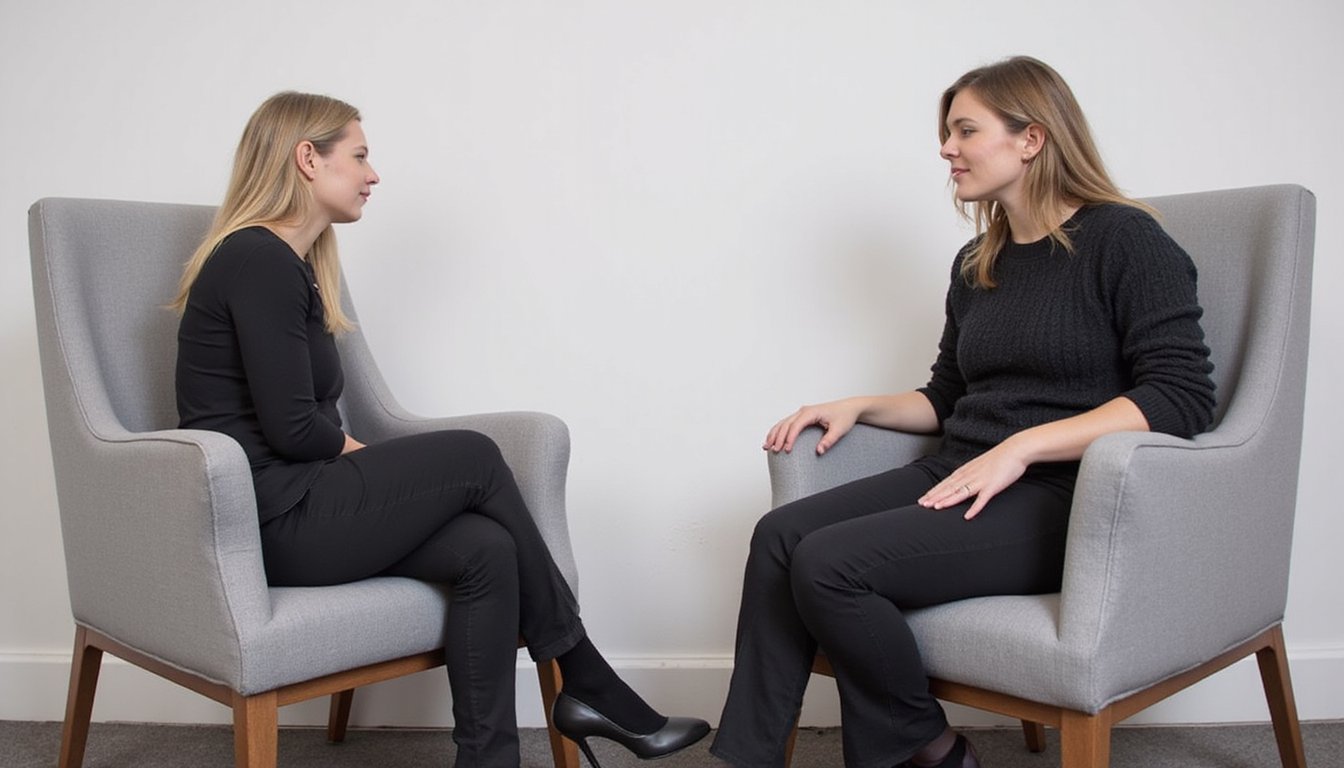Therapists and clients work together by forming a strong therapeutic alliance built on mutual trust, shared goals, and open communication. You’ll collaborate with your therapist to identify meaningful treatment targets, track progress, and adjust plans as needed. Together, you’ll establish clear boundaries while maintaining authentic interactions that foster understanding and growth. The best therapeutic outcomes emerge when both you and your therapist actively engage in this partnership, setting the foundation for deeper exploration of effective treatment strategies.
Understanding the Therapeutic Alliance

While many factors contribute to successful therapy outcomes, the therapeutic alliance stands as a cornerstone of effective psychological treatment. This alliance isn’t just about friendliness; it’s a complex, dynamic partnership built on three key elements: shared goals, agreed-upon tasks, and a genuine interpersonal bond between you and your therapist. Research consistently demonstrates that explicit negotiation between therapist and client helps address underlying needs and desires. Your therapist’s therapeutic stance adjustment plays a fundamental role in fostering this collaboration. Rather than maintaining strict neutrality, they’ll work to create a supportive environment where you both actively participate in setting objectives and choosing methods. Through alliance focused interventions, your therapist helps maintain and repair this working relationship when needed. Research highlights that establishing early rapport is crucial for treatment success. The development of mutual trust enables both parties to communicate openly about difficult experiences and challenges. Research shows this collaborative approach accounts for up to 30% of treatment success, making it more influential than specific therapeutic techniques alone.
Essential Elements of Client-Therapist Partnerships
Building on the therapeutic alliance requires specific foundational elements that shape successful client-therapist partnerships. These partnerships thrive when you establish clear professional boundaries while fostering mutual understanding through shared decision-making and authentic interactions. Most successful alliances peak by session three, making early relationship-building crucial for long-term treatment success. Therapists must demonstrate unconditional positive regard to help clients feel accepted and safe in the therapeutic space. Meta-analyses consistently show that a strong therapeutic alliance predicts improved clinical outcomes.
| Essential Element | Key Benefit |
|---|---|
| Shared Goals | Increases treatment adherence |
| Open Feedback | Enables continuous improvement |
| Clear Boundaries | Maintains therapeutic safety |
| Active Collaboration | Bolsters client engagement |
You’ll find that successful partnerships develop through empathetic responses and genuine dialogue. When you actively participate in goal-setting and provide regular feedback, you’re more likely to experience positive therapeutic outcomes. Research shows that transparent communication about treatment methods and expected results strengthens the working relationship, while upholding professional boundaries secures a safe environment for growth and healing.
Building Trust and Rapport in Therapy

To establish effective therapeutic relationships, clinicians must master both verbal and nonverbal elements of communication, with research showing that 93% of rapport-building relies on nonverbal cues. Building trust requires a nonjudgmental attitude, cultural competence, and consistent demonstration of empathy through active listening and responsive feedback. When therapists create a safe environment and maintain clear boundaries, clients feel more comfortable sharing sensitive information. A strong therapeutic alliance has been consistently linked to positive treatment outcomes across various therapeutic approaches. The development of mutual understanding between therapist and client regarding treatment goals is essential for successful therapy. While in-person interactions are traditional, digital services can provide viable alternatives when face-to-face care is not feasible.
- Maintain appropriate eye contact and open body language to convey warmth and attentiveness
- Practice active listening by providing undistracted attention and reflective responses
- Demonstrate cultural competence by respecting diverse backgrounds and adapting interventions accordingly
- Guarantee confidentiality and establish clear expectations about the therapy process
- Mirror client’s behavior subtly to amplify connection while maintaining professional boundaries
These evidence-based practices lead to higher engagement rates and improved treatment outcomes across diverse populations.
Goal Setting and Treatment Planning Together
Setting clear treatment goals with your therapist creates a roadmap for your therapeutic expedition and increases the likelihood of successful outcomes. Through shared decision-making, you’ll work together to identify meaningful objectives that align with your needs and values, while ensuring these goals remain realistic and achievable. Recent studies show that educational workshops for therapists significantly improve their ability to engage in collaborative goal setting with clients. Regular progress tracking helps you and your therapist measure advancement in the direction of these established targets, allowing for timely adjustments to your treatment plan when needed. Using the SMART goal framework helps transform abstract desires into concrete, actionable steps that can be effectively monitored and achieved. This collaborative approach provides a shared language between you and your therapist to build trust and enable progress in your therapeutic journey.
Establishing Clear Treatment Targets
Clear treatment targets form the cornerstone of successful collaborative therapy, driving positive mental health outcomes for clients struggling with anxiety and depression. When you work with your therapist to establish personalized targets and culturally responsive goals, you’ll create a structured path toward improvement. Using frameworks like SMART goals guarantees your objectives remain focused and achievable while respecting your unique circumstances and values. Research shows that achieving perfect agreement between therapists and clients on treatment goals occurs in only about 18% of cases. The process of shared decision-making helps ensure both clinician and patient perspectives are considered when developing treatment plans. Studies demonstrate that practicing mindfulness-based therapy can significantly improve your ability to set specific goals and achieve them more consistently.
- Track your progress through systematic data collection and regular review sessions
- Break down larger goals into manageable, stepwise achievements
- Align treatment targets with your daily experiences and personal aspirations
- Celebrate small victories to maintain motivation and engagement
- Adjust goals flexibly as your needs change throughout the therapeutic expedition
This collaborative approach empowers you to take an active role in your treatment while maintaining clear direction and measurable outcomes.
Shared Decision-Making Process
Shared decision-making represents three essential pillars of collaborative therapy: mutual respect, informed choice, and active participation. When you engage in this process with your therapist, you’ll work together through key steps that guarantee treatment aligns with your values and goals.
Your therapist will start by building rapport and understanding your situation, while coordinating choices that match your needs. Through open dialogue and educational resources, you’ll learn about evidence-based treatment options and their potential outcomes. This approach focuses on enhancing motivation by addressing any concerns or ambivalence you might have about treatment.
Together, you’ll use decision aids and goal-setting tools to create a measurable treatment plan that reflects both clinical expertise and your priorities. Regular feedback verifies the plan remains responsive to your needs and progress.
Measuring Progress Together
When you and your therapist collaborate on measuring progress, you’ll establish meaningful goals that increase treatment engagement by up to 32%. Through structured frameworks like SMART goals, you’ll work together in monitoring data patterns and evaluating milestone achievements. This systematic approach guarantees your treatment stays focused, adaptable, and aligned with your personal needs.
- Track your progress through regular journaling and scheduled reviews, making it easier to identify patterns and adjust strategies
- Set specific, measurable objectives that transform broad concerns into actionable steps
- Celebrate small victories to maintain motivation and positive momentum
- Use evidence-based tools to evaluate your success and inform future treatment planning
- Participate in ongoing assessment to verify your therapy remains relevant and effective as your needs evolve
Measuring Progress and Adapting Care
Measuring progress in collaborative therapy requires a systematic approach that combines validated assessment tools with regular monitoring practices. You’ll use standardized assessments like PHQ-9 or GAD-7 alongside session rating scales to track both symptoms and client well-being. Through qualitative data review and leveraging client insights, you’ll gather extensive information about treatment effectiveness.
You’ll monitor progress every session or bi-weekly, tracking both objective measurements and subjective experiences. This systematic approach helps you identify trends, plateaus, and necessary treatment adjustments. When interpreting results, you’ll collaborate with your client to understand their perspective and adjust treatment plans accordingly. If progress stalls, you can modify interventions, adjust the pace, or consider referrals based on the collected data.
Communication Strategies for Successful Outcomes

Establishing open communication channels with your therapist creates the foundation for successful collaborative therapy through consistent, transparent dialogue. You’ll build trust more effectively when you engage in active listening practices, share feedback honestly, and express your needs clearly during sessions. Your willingness to maintain open lines of communication, combined with your therapist’s responsive engagement, strengthens the therapeutic alliance and leads to better treatment outcomes.
Clear Channels Stay Open
Maintaining clear communication channels forms the cornerstone of successful collaborative therapy outcomes. Through structured communication and transparent information sharing, you’ll experience a more effective therapeutic relationship. Your therapist will establish defined protocols and provide clear explanations about methods, expectations, and any changes in your treatment plan.
- Regular feedback sessions help monitor progress and address any concerns promptly
- Written materials and visual aids supplement verbal discussions to bolster understanding
- Secure messaging between sessions maintains continuity and addresses urgent questions
- Active listening techniques guarantee your perspective is accurately comprehended
- Systematic outcome monitoring helps adjust treatment strategies for ideal results
This multi-channel approach guarantees you stay informed, engaged, and empowered throughout your therapeutic expedition while maintaining professional boundaries and confidentiality standards.
Building Trust Through Dialogue
Trust in the therapeutic relationship flourishes through skillful communication strategies that combine empathy, respect, and cultural awareness. When you validate emotions and demonstrate genuine understanding, you create a safe space for authentic emotional expression. Research shows this approach can improve client retention by up to 40%.
Your consistent display of respect and non-judgment encourages mutual understanding, especially across diverse cultural backgrounds. Being transparent about therapy processes while maintaining professional boundaries helps establish clear expectations. Pay attention to your nonverbal cues, as they profoundly impact how clients perceive empathy and support. Remember that cultural competence plays a crucial role, acknowledge your limitations and remain open to learning about your client’s unique perspectives. These evidence-based practices foster trust and lead to better therapeutic outcomes.
Active Listening Creates Connection
Active listening stands at the forefront of successful therapeutic relationships, backed by compelling neurobiological evidence. When you engage in active listening, your brain’s ventral striatum activates, creating a reward response that deepens emotional attunement. Through empathic engagement, you’ll establish a safe environment that encourages open dialogue and meaningful connection with your clients.
- Use reflective statements to demonstrate understanding and validate experiences
- Pay attention to non-verbal cues for complete emotional awareness
- Allow strategic silence to give space for processing thoughts
- Ask open-ended questions to promote deeper exploration
- Provide thoughtful feedback to reinforce the client’s perspective
This evidence-based approach not merely strengthens therapeutic rapport but also leads to improved mental health outcomes, greater engagement, and lasting trust between therapist and client.
Overcoming Barriers to Effective Collaboration
Successful collaboration in therapy faces several considerable barriers that practitioners must actively address to guarantee positive outcomes. Key challenges include multicultural considerations and organizational limitations that can impede the therapeutic alliance and treatment effectiveness.
You’ll find that mismatches between therapist and client styles, particularly in attachment patterns or cultural backgrounds, can dramatically impact trust and engagement. Poor cultural competence leads to higher dropout rates, while inadequate organizational resources and unwelcoming environments restrict access to care. These barriers are often more pronounced in socioeconomically disadvantaged communities.
To overcome these obstacles, therapists need to boost their cultural responsiveness, develop flexible communication strategies, and work within their organizations to improve service delivery. Building strong therapeutic alliances and addressing client resistance through empathy and understanding are essential steps in the direction of successful collaboration.
Enhancing Treatment Through Shared Decision Making
How can practitioners optimize treatment outcomes through shared decision making (SDM)? Research shows that implementing SDM strategies augments patient satisfaction and reduces decisional conflict, particularly when you utilize evidence-based decision aids and validated assessment tools. While SDM doesn’t drastically impact consultation duration, it consistently improves communication and knowledge scores across diverse patient populations.
Shared decision making empowers patients and practitioners alike, fostering better communication and outcomes through evidence-based collaboration and mutual understanding.
- Using decision aids heightens patient knowledge by an average of 13.9 points on standardized scales
- Cultural adaptations of SDM models are pivotal for addressing local healthcare contexts
- SDM effectiveness spans across maturity, sex, and education levels, though more research is needed for underrepresented populations
- Comprehensive counseling within SDM frameworks diminishes treatment apprehension
- Full implementation, including personalized information, yields better satisfaction outcomes than partial approaches
When properly executed, SDM strengthens the therapeutic alliance and amplifies treatment adherence, especially in mental health and chronic condition management.
Keys to Long-Term Therapeutic Success
The foundation of long-term therapeutic success rests on five key pillars: a strong therapeutic alliance, customized treatment approaches, evidence-based practice integration, structured follow-up protocols, and therapist competence.
You’ll achieve better outcomes when your therapist develops a potent alliance with you through empathy, understanding, and safety. Personalized intervention approaches that consider your unique needs, background, and circumstances drive sustained improvement. Your treatment plan should incorporate evidence-based practices adapted specifically to your situation through individualized treatment planning. Regular follow-up sessions and maintenance strategies help prevent relapse and guarantee lasting change. Your therapist’s ability to build strong relationships, even with complex cases, while implementing proven techniques, greatly impacts your long-term success in therapy.
Frequently Asked Questions
How Does Cultural Background Influence the Collaborative Therapeutic Approach?
Your cultural background shapes how you engage in therapy through ethnic customs and societal norms that influence communication styles, trust-building, and healing beliefs. You’ll experience better outcomes when your therapist actively acknowledges and incorporates your cultural identity into treatment approaches. They should adapt their methods to align with your cultural values, including traditional practices and religious beliefs, while considering how historical experiences and systemic factors impact your therapeutic expedition.
What Role Do Family Members Play in Collaborative Therapy Sessions?
When considering family systems, your family members serve as essential partners in collaborative therapy. They’ll provide pivotal context about family dynamics, help set meaningful goals, and support your therapeutic progress. You’ll find that family involvement amplifies engagement, reduces dropout rates, and improves long-term outcomes. Your family members also facilitate better communication, monitor behavioral changes, and provide emotional reinforcement throughout the therapeutic process. Together, you’ll work on sustaining positive changes and strengthening relationships.
How Often Should Therapy Sessions Occur for Optimal Collaborative Outcomes?
You’ll achieve ideal outcomes by starting with weekly sessions during the preliminary 4-6 weeks of therapy. Regular scheduling at this frequency allows you to build momentum and establish a strong therapeutic alliance. Based on your progress and needs, your therapist might recommend adjusting session frequency, potentially increasing it for crisis situations or decreasing it as you stabilize. Research shows that more frequent sessions in the initial phase lead to faster improvement and better recovery rates.
Can Collaborative Therapy Work Effectively in Crisis or Emergency Situations?
Yes, collaborative therapy is highly effective in crisis situations. When you’re experiencing an emergency, crisis intervention strategies that involve multiple professionals working together can provide more extensive support. You’ll benefit from immediate access to emergency support resources and coordinated care from teams trained in trauma-informed approaches. Research shows that collaborative responses lead to better outcomes, reduced escalation, and improved safety for everyone involved during critical situations.
What Happens if Client and Therapist Disagree on Treatment Direction?
When you and your therapist have differing treatment goals, it’s vital to address the disagreement openly. You’ll need to engage in honest dialogue about your concerns while managing power dynamics carefully. Your therapist should remain flexible and responsive, adapting their approach based on your feedback. Research shows that explicitly negotiating treatment direction and finding compromise leads to better outcomes. If unresolved, these disagreements can damage the therapeutic alliance and reduce treatment effectiveness.





